Who’s Next?
It happened again last week. A meeting that started as a project planning session ended with a discussion about how a lot of the well-known faces in the industry are about to change. In some cases, the timeline for these well-deserved retirements is measured in months. In other cases, it’s a couple of short years. But too often, it seems, there has not been a lot of serious thinking about who will step up or step in when (insert name here) inevitably takes the career off ramp.
While I’m writing about the steel framing industry, it’s the same story for the construction industry overall as statistics show that the workforce appears to be aging faster than it can recruit the next generation of workers. According to the Bureau of Labor Statistics, the average age of a construction worker has increased from 37.6 to 42.6 years over the last decade. By comparison, the average age for all workers in the United States only grew by less than a single year during the same period.
This is not to re-hash all the conversations about worker shortages and engaging the next generation of management. We all know it’s an issue. Instead, this is about transformation, and the opportunity to think strategically about our industry’s next generations.
Starting With Transformation
The cold-formed steel framing industry that I entered back in the 1990s has seen a lot of change. For starters, back then the product was called “light gauge” in all the publications, codes and standards. Since then, our industry has been inundated with innovations to how framing is manufactured, fastened and connected, ordered, shipped and used to build structures. Technology is rapidly changing how projects are planned, designed and assembled. Building and energy codes and standards have also been added to the mix.
Together, these factors have already transformed the industry from one centered around the traditional studs, screws and drywall, to one where a good software package and technical tools are just as important as having a screw gun with the right RPMs.
But we still have a long way to go. If you’re a regular reader of my columns, you know I spend a lot of time thinking about the big changes coming down the road that will make our industry better and more efficient – including products with more advanced performance at a lower cost, and further shrinking our environmental footprint.
 Bar Graph Credit: SFIA
Bar Graph Credit: SFIA
Transformation Creates Opportunity
With these industry changes comes an opportunity to envision what the next generation of leaders should look like, and to let go of the traditional image of the stereotypical “construction worker.”
In fact, there’s an entire gender of future leaders that we’ve not broadly and actively invited to be a part of our industry. Numbers tell the tale: According to the Current Population Survey, women currently make up only 11 percent of the construction workforce. Of these, 71 percent are in sales and office jobs, while only 17 percent are in management and professional positions.
This represents a huge potential opportunity to address the labor shortage, while also creating the potential to improve productivity, efficiency, and profit. In fact, a 2015 study by McKinsey finds that companies that have the most gender diversity tend to have profits that outperform their competition by 15 percent. And yet a quick sampling of job postings for construction industry jobs seems to assume that only males will apply.
While we are fortunate to have more and more extraordinary women in leadership positions, there is more we can do to break the stereotypical male-dominated view of a career in construction:
- Communicate a clear career path with promotion opportunities
- Consider benefits and incentives that may be more important for one gender than the other
- Provide mentoring and networking opportunities
- Create opportunities for apprenticeships and real-life work experience
- Enforce zero tolerance for bad behavior in the workplace
New Faces from Different Places
The growing pervasiveness of technology and digitized processes in our industry will also introduce a range of new potential leadership candidates with more diverse educational backgrounds and work experience.
The traditional path to top leadership positions went through positions in finance, sales, or operations. Today I believe that path should also include IT professionals, data analysts, and mechanics that know as much about systems that rely on pneumatics and hydraulics as they do framing.
There’s no time like the present to think about the future!
While a lot of the chatter I hear is about the coming wave of retirements, it would be a shame to wait until the next generation is thinking about moving on before planning for their successors.
I hope that we’re already considering how we’re going to recruit, retain and develop the potential leadership group that follows. In broad terms, that group is Generation Z—often defined as those born between 1997 and 2012—who today are between 11 and 26 years old.
Unlike recent generations whose focus has largely been on moving from high school directly to university, Gen Z members are amenable to pursuing training and education that doesn’t automatically include college. In fact, a McKinsey survey found 61 percent said they thought a "skill-based education," such as coding bootcamp, trade schools, or similar options, was a sensible choice. Similarly, 45 percent said it "makes sense" to consider a secondary education program of two years or less.
In fact, construction work—whose product is publicly visible for generations, crucial to people’s daily lives, and in the throes of R&D-driven technological reinvention—seems a perfect fit for this an group interested in making a lasting contribution to society and the world.
We should remember that old Greek proverb: “Great societies plant trees under whose shade they shall never sit.” Similarly, I think we should be planting our own trees to ensure that the cold-formed steel framing industry stays on the path to greatness.






Report Abusive Comment